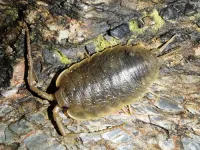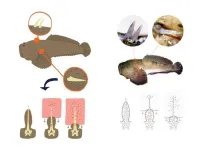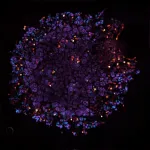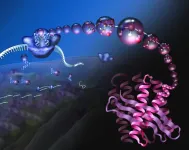(Press-News.org) Artificial night-time light confuses a colour-changing coastal woodlouse, new research shows.
The sea slater is an inch-long woodlouse that lives around the high-tide line and is common in the UK and Europe.
Sea slaters forage at night and can change colour to blend in and conceal themselves from predators.
The new study, by the University of Exeter, tested the effects of a single-point light source (which casts clear shadows) and “diffuse” light (similar to “skyglow” found near towns and cities).
While the single light did not interfere with the sea slaters’ camouflage, diffuse light caused them to turn paler while hiding on a dark background – making them more visible.
“With night skies getting brighter worldwide, it’s important to understand how this will affect the natural world,” said Kathryn Bullough, who led the study as part of her masters at the Centre for Ecology and Conservation on Exeter’s Penryn Campus in Cornwall.
“We know artificial light causes all sorts of negative effects for animals and plants, but our results show that shadow-casting light can have very different impacts to diffuse skyglow, even when both have the same overall brightness.
“Under point-source light, the sea slaters turned darker and sought out refuge on dark stones and shadows when available.
“But diffuse light caused them to become lighter, even though this would make them easier for predators to spot.”
In the study, sea slaters were placed in a circular chamber with white pebbles covering half of the floor and black pebbles on the other half.
They were then exposed either to point-source or diffuse light.
Under both kinds of light, sea slaters spent more time on the black pebbles, which more closely matched their starting colour and therefore provided better camouflage.
Under point-source light, they also turned darker – better matching the black pebbles.
But under diffuse light, they became on average 27% lighter.
“We can’t say exactly what causes this, but diffuse light clearly interferes with the sea slaters’ colour-matching mechanism,” said Dr Jolyon Troscianko, also from the Centre for Ecology and Conservation.
“One possibility is that they respond to this light as if dawn was approaching.
“We know that nocturnal animals have very sensitive light vision, so skyglow will appear very bright to them.”
With human populations clustered in coastal areas, shorelines are disproportionately affected by light pollution.
While sea slaters are not a threatened species, they are commonly eaten by shore birds such as oystercatchers and gulls.
“Many shore bird species are in severe decline, so it is critical that we understand how human activity affects their prey as part of a complex ecosystem,” Dr Troscianko said.
The study was partly funded by the Natural Environment Research Council (NERC).
The paper, published in the journal Proceedings of the Royal Society B, is entitled: “Artificial light at night causes conflicting behavioural and morphological defence responses in a marine isopod.”
END
Light pollution confuses coastal woodlouse
2023-06-14
ELSE PRESS RELEASES FROM THIS DATE:
Giving birth outside of working hours in England is safe, suggests study
2023-06-14
A new study suggests that between 2005 and 2014, for almost all births in England, being born outside of working hours did not carry a significantly higher risk of death to the baby from anoxia (lack of oxygen) or trauma, when compared to births during working hours.
The finding runs contrary to an assumed, wider ‘weekend effect,’ with previously reported research suggesting a significantly higher risk of death for births outside of working hours or at weekends.
The current study from City, University of London ...
Brighter nights risk extinguishing glow-worm twinkle
2023-06-14
The bright lights of big cities are wonders of the modern world; intended to help us work, stay safe and enjoy the world around us long after the sun has set. While artificial light has been great for increasing human productivity, some nocturnal animals, and even people, pay a price for this illumination. From increasing the amount of time that predators are active to disrupting migrations, light pollution affects many animals; but how do animals that use their own luminescence to lure food or attract mates fair against this new, brighter background? Female common glow-worms (Lampyris noctiluca) emit a green glow from their abdomen to ...
Meat processing plants: What factors are critical for survival?
2023-06-13
URBANA, Ill. — Meat processing plants in the U.S. have garnered considerable public attention in recent years, often focusing on production and labor issues. The COVID-19 pandemic underscored the vulnerability of large, concentrated plants, as major shutdowns led to reduced output and higher meat prices for consumers.
Policy makers have launched initiatives at the state and federal levels to increase meat processing capacity and industry resilience, often favoring small and medium-sized plants. But little research exists to determine what factors make plants more likely to succeed. A new study from the University of ...
CHOP researchers develop universal MHC molecules that can be produced rapidly at scale
2023-06-13
Philadelphia, June 13, 2023— Class I major histocompatibility complex (MHC-I) proteins play an essential role in the immune system of all jawed vertebrates. The MHC-I displays peptide fragments of proteins from within the cell on the cell surface, “presenting” them to the immune system, which is constantly scanning the body for foreign or toxic antigens. When foreign peptides are identified, they trigger a cascade that allows cytotoxic T cells to eliminate intruders. This process has been exploited in the development of both vaccines ...
Peptide from venomous fish toxin controls lung inflammation in mice
2023-06-13
A molecule found in the venomous toadfish Thalassophryne nattereri has proved capable of controlling lung inflammation and could be the basis for a more effective asthma drug. The research was supported by FAPESP and conducted by scientists at Butantan Institute in São Paulo, Brazil. An article describing the results is published in the journal Cells.
A welter of fish species live in freshwater, seawater and a mixture of the two, and some of them are venomous. They have spines or stingers connected to venom glands, which ...
Residents in 'digital deserts' have fewer health care options
2023-06-13
Residents in rural counties with limited access to high-speed internet cannot take advantage of increasingly popular online health services.
A new study by the University of Cincinnati highlighted disparities in access to digital technology that could widen the gap in access to health care. The study found that socially vulnerable communities in the United States face more barriers to adequate health care, live in areas with fewer health care resources and have less access to high-speed internet.
The study was published in the journal Mayo Clinic Proceedings: Digital Health.
The Biden Administration announced this year it will invest $73 million in outreach ...
Different genes are expressed at different stages during pregnancy, according to scientists
2023-06-13
We have a good understanding of how a woman’s external features can change during pregnancy, but scientists know surprisingly little about what biological changes occur internally.
A new Northwestern Medicine study, published June 5 in the journal Frontiers in Immunology, provides data about immune cells and biological changes (gene expression) in pregnant people at multiple timepoints before and during pregnancy. Using RNA sequencing and computational methods to estimate proportions of different activated types of immune cells in blood the team of scientists showed how pregnancy induces progressive changes in the maternal ...
USC Stem Cell’s journey towards 1,000 mini-kidneys begins with $1 million from KidneyX
2023-06-13
To help patients in need of transplants, artificial kidneys would have to function like their natural counterparts, but they wouldn’t necessarily have to look like them. With a new $1 million prize from the Kidney Innovation Accelerator, or KidneyX, a team of USC Stem Cell scientists led by Nils Lindström in collaboration with Leonardo Morsut are on a quest to build a kidney that resembles the real thing in function, but not in form.
“Nature has taught us that kidneys can come in an ...
Retooling the ribosomal translation machine could expand chemical repertoire of cells
2023-06-13
Synthetic biologists have become increasingly creative in engineering yeast or bacteria to churn out useful chemicals — from fuels to fabrics and drugs — beyond the normal repertoire of microbes.
But a multi-university group of chemists has a more ambitious goal: to retool the cell's polypeptide manufacturing plants — the ribosomes that spin amino acids into protein — to generate polymer chains that are more elaborate than what can now be made in a cell or a test tube.
The $20 million research enterprise centered at the University of California, Berkeley, is ...
Sickle cell disease is 11 times more deadly than previously recorded
2023-06-13
A new analysis provides a more complete picture of sickle cell disease mortality burden by combining disease prevalence data in different age groups and trends in overall survival when factoring in resulting secondary conditions.
When looking across all deaths, sickle cell disease is a leading cause of mortality in children under 5 years as well as in youth 5–14 years and adults 15–49 years.
Half a million babies were born with sickle cell disease in 2021, and 79% of these infants were in sub-Saharan Africa.
The largest increases ...







